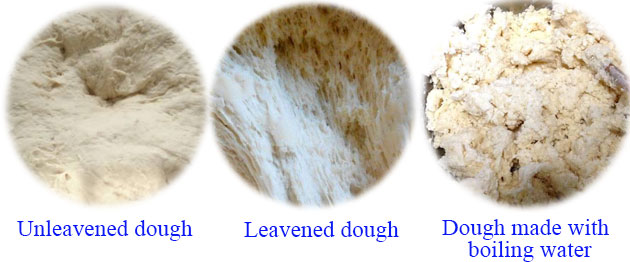Different Methods Of Dough Mixing
2019-01-28
As everyone knows, dough mixing is the most basic step in making a pastry, usually people choose the right way of mixing dough according to the kind of pastry. But do you know what are dough mixing methods? Today, we will introduce the dough mixing methods in detail.

Common dough mixing methods:
1. Unleavened dough
Unleavened dough is very chewy.
Mixing method: Mix well with cold water and flour.
Nutritional characteristics: Not easy to digest, resistant to cooking, strong taste, chewy, low glycemic index.
People suitable: Diabetes and obese people.
2. Leavened dough
Making buns using this production technique.
Mixing method: Yeast is added to the dough, and under certain conditions of temperature and humidity, the yeast is allowed to multiply and produce gas, which promotes the expansion of the dough.
Nutritional characteristics: The nutritional value is high, and the added yeast can decompose and affect the phytic acid absorbed by calcium, magnesium, iron and other elements, and improve the absorption and utilization of calcium, magnesium, iron and other elements in the human body, and the B vitamins of the flour after fermentation will also increase significantly. .
People suitable: People with poor stomach, children with weaker digestion and the elderly.

3. Dough made with boiling water
Mixing method: Use boiling water (about 65 ° C to 100 ° C) mixing flour, stir while adding water, wait until the temperature is lowered, then smash the pellet and make into various foods.
Nutritional characteristics: It is made of medium-gluten flour, because the flour above the medium-gluten has a large amount of protein, and can produce enough gluten as a pillar, and the finished product will not be sticky.
After reading the above, everyone has some understanding of dough mixing methods. You can choose the right method according to your actual needs. These methods can be done manually or by means of a dough mixer.

Common dough mixing methods:
1. Unleavened dough
Unleavened dough is very chewy.
Mixing method: Mix well with cold water and flour.
Nutritional characteristics: Not easy to digest, resistant to cooking, strong taste, chewy, low glycemic index.
People suitable: Diabetes and obese people.
2. Leavened dough
Making buns using this production technique.
Mixing method: Yeast is added to the dough, and under certain conditions of temperature and humidity, the yeast is allowed to multiply and produce gas, which promotes the expansion of the dough.
Nutritional characteristics: The nutritional value is high, and the added yeast can decompose and affect the phytic acid absorbed by calcium, magnesium, iron and other elements, and improve the absorption and utilization of calcium, magnesium, iron and other elements in the human body, and the B vitamins of the flour after fermentation will also increase significantly. .
People suitable: People with poor stomach, children with weaker digestion and the elderly.

3. Dough made with boiling water
Mixing method: Use boiling water (about 65 ° C to 100 ° C) mixing flour, stir while adding water, wait until the temperature is lowered, then smash the pellet and make into various foods.
Nutritional characteristics: It is made of medium-gluten flour, because the flour above the medium-gluten has a large amount of protein, and can produce enough gluten as a pillar, and the finished product will not be sticky.
After reading the above, everyone has some understanding of dough mixing methods. You can choose the right method according to your actual needs. These methods can be done manually or by means of a dough mixer.



 Message
Message